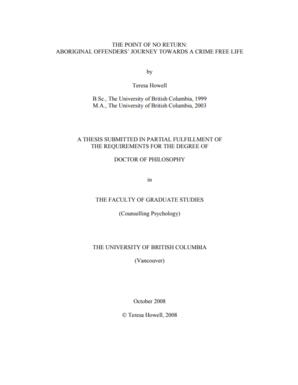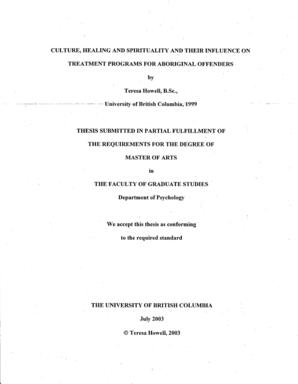University of British Columbia. Psychology
Related Works
Content type
Digital Document
Abstract
The goal of this study was to gather information from Aboriginal offenders and develop a categorical map that describes the factors that help and hinder maintaining a crime free life after incarceration. The critical incident technique was utilized to examine 42 Aboriginal offenders’ journeys from prison to the community. Three hundred and forty-one incidents collapsed into nine major categories representing themes that were helpful in maintaining a crime free life: 1) transformation of self; 2) cultural and traditional experiences; 3) healthy relationships; 4) having routine and structure in daily living; 5) freedom from prison; 6) purpose and fulfillment in life; 7) attempting to live alcohol and drug free; 8) professional support and programming; and 9) learning to identify and express oneself. Seventy-eight incidents formed four categories representing obstacles that interfere with maintaining a crime free life: 1) self; 2) unhealthy relationships; 3) substance use; and 4) lack of opportunity and professional support. The findings were compared and contrasted to two major theories in the literature: desistance and the risk-needs-responsivity principle. Most of the categories were well substantiated in the literature contributing knowledge to theory, policy, practice, and the community. Information obtained from this study provides an increased understanding of the needs of Aboriginal offenders and offers guidance concerning useful strategies to incorporate into their wellness plans when entering the community, most notably respecting Aboriginal culture and traditional practices. The findings also add awareness of those circumstances, issues, and problems that arise during transition that may be harmful or create obstacles to a successful transition.
Origin Information
Content type
Digital Document
Abstract
This study investigated the role of culture, healing and spirituality in treatment programs for Aboriginal offenders. Aboriginal people have been profoundly affected by their contact with Europeans and one negative consequence is their over-representation in the Canadian Criminal Justice System (CJS) (Chisholm, 1994). In British Columbia, Aboriginal adults constitute approximately 5% of the population, but they represent 20% of those incarcerated; Aboriginals comprise 8% of the adult population in Saskatchewan, yet they constitute 76% of incarcerated individuals (Boe, 2000). By virtue of their overrepresentation, Aboriginals present as a special interest group in the CJS. As the Correctional Services of Canada (CSC) implements a number of treatment programs that Aboriginal inmates have an opportunity to attend (CSC webpage, www.csc-scc.gc.ca ), knowledge of the effectiveness of these programs is important. A total of 50 offenders participated in the study: 40 Aboriginal men and 10 non-Aboriginal men. Participants were required to fill out a research package consisting of the following components: a consent form, a background information questionnaire, a treatment/program involvement questionnaire, the Native American Acculturation Scale, and the Balanced Inventory for Desired Responding. The results of the study support prior findings (Hodgson & Heckbert, 1994; Johnston, 1997; Waldram, 1993) indicating that spirituality, culture and practicing traditions are fundamental components of treatment programs for Aboriginal offenders. More specifically, many Aboriginal participants (52%) in this sample indicated that they considered Aboriginal programs effective because of their cultural and spiritual components. Additionally, Aboriginal participants reported that healing contributed to treatment effectiveness for both Aboriginal programs (44%) and, to a lesser extent, non Aboriginal programs (18.5%). Furthermore, an encouraging discovery was that these participants reported that Aboriginal programs are, in their view, moderately (28%) to highly (40%) likely to decrease their recidivism. Additionally, Aboriginal participants also reported that they most often solicit assistance and support from Aboriginal people when experiencing personal problems (92.5%), institutional problems (85%) and consider Aboriginal people to be the most supportive people (90%). Although results indicated that it is necessary for CSC to be culturally sensitive in accommodating Aboriginal offenders, further research is required to investigate the actual, as opposed to perceived, effectiveness of current Aboriginal programs operating at CSC, as well as assisting in designing and implementing future programs and activities that are culturally appropriate.
Origin Information


